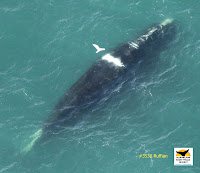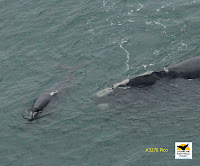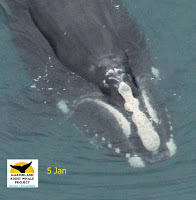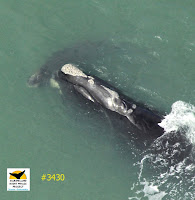 Yesterday, 24 January, the AirCam crew of Joy and Becki discovered a mother and calf two miles south of Ponce Inlet. For several minutes, only the calf appeared at the surface, intermittently, swimming north, causing Joy and Becki to wonder if they were observing a very small yearling or an orphaned calf. Then, mom rose into view through the turbid water. She has been provisionally identified as #3430, age seven years with her first calf. We photographed her from the AirCam on 4 January in
Yesterday, 24 January, the AirCam crew of Joy and Becki discovered a mother and calf two miles south of Ponce Inlet. For several minutes, only the calf appeared at the surface, intermittently, swimming north, causing Joy and Becki to wonder if they were observing a very small yearling or an orphaned calf. Then, mom rose into view through the turbid water. She has been provisionally identified as #3430, age seven years with her first calf. We photographed her from the AirCam on 4 January in Tuesday, January 25, 2011
Returning Right Whale Mothers
 Yesterday, 24 January, the AirCam crew of Joy and Becki discovered a mother and calf two miles south of Ponce Inlet. For several minutes, only the calf appeared at the surface, intermittently, swimming north, causing Joy and Becki to wonder if they were observing a very small yearling or an orphaned calf. Then, mom rose into view through the turbid water. She has been provisionally identified as #3430, age seven years with her first calf. We photographed her from the AirCam on 4 January in
Yesterday, 24 January, the AirCam crew of Joy and Becki discovered a mother and calf two miles south of Ponce Inlet. For several minutes, only the calf appeared at the surface, intermittently, swimming north, causing Joy and Becki to wonder if they were observing a very small yearling or an orphaned calf. Then, mom rose into view through the turbid water. She has been provisionally identified as #3430, age seven years with her first calf. We photographed her from the AirCam on 4 January in Thursday, January 20, 2011
A Large Group and a New Mom
 We are approaching the busy point in our typical season and the whales are turning up with more frequency. On Sunday, 16 January, the AirCam crew of Joy and Sheila confirmed a group of 13 adult/juveniles in Ormond/Daytona Beach. The
We are approaching the busy point in our typical season and the whales are turning up with more frequency. On Sunday, 16 January, the AirCam crew of Joy and Sheila confirmed a group of 13 adult/juveniles in Ormond/Daytona Beach. The  On Tuesday, 18 January, Sector 2 reported a sighting from
On Tuesday, 18 January, Sector 2 reported a sighting from Tuesday, January 11, 2011
Mother and Calf Right Whales in Ormond
Thursday, January 6, 2011
AirCam Helps Out
Our surveys began on Monday, 3 January and at 9:10 on Wednesday morning, 5 January, the

Hammock Dunes team became the first of the survey season to call in a whale sighting. Shortly thereafter, Team 3 called from

This shows the value of the plane to accurately report sightings, and underlines the importance of careful observation. The photos are of one of the whales, taken from the land and AirCam. Note the dolphin’s dorsal fin in the land photo and the unusual series of small callosities along the whale’s lower jaw in the AirCam photo. ID’s for both of the whales are pending.
On Tuesday, 4 January, a call to the Right Whale Hotline resulted in a sighting in north
to the north of the area we usually cover, the AirCam was in the vicinity on survey and gladly detoured to assist in documenting the pair. The female is tentatively identified as #3430, a seven-year-old female with her first calf. They have been sighted several times in this general area in the last week or so. We saw her as a calf in 2004 and again as a yearling in 2005.

Sunday, January 2, 2011
End of Year Right Whale Sightings
The year ended on a high note with right whale sightings on the 28th, 29th and 30th of December, including two mother/calf pairs we have not seen yet this season. On 28 December, a resident of Windjammer Condo in

tentatively identified as #1604 with a calf. She is an older female, 25 years or more, and has had at least one calf before this one. The Marineland Project documented her in our area on 25 January and 28 February in 2005.
29 and 30 December were stellar weather days and we took advantage of them by flying two surveys in the AirCam on the 29th, our typical coastal survey and an afternoon flight three miles offshore. On this flight, we sighted a single adult/juvenile right on the survey line east of
On 30 December we flew a standard coastal survey and spotted a female tentatively identified as #3010 and her calf just north of the St. Augustine Inlet, our turnaround spot. This was the first time we have documented this female and it was the first sighting of her this season with a new calf. She is at least 11 years old and this is at least her second calf.

Eleven mothers and calves have been provisionally identified in the



